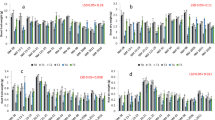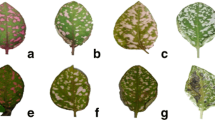Abstract
Ozone (O3) is one of the major pollutants in near-surface air. In order to protect sensitive plants from O3 pollution, many kinds of protectants including synthetic ones, were assessed in previous studies. Although they have certain protective effects, some of them are not environment-friendly. In the present study, leaf water extracts of aromatic plants [Plectranthus hadiensis var. tomentosus (PHT), Pelargonium hortorum (PHB), Tagetes patula (TP)] were compared for mitigating the damages caused by O3 (150 ppb for 3 days, 8 h day−1) on snap bean (Phaseolus vulgaris ‘Jiangjunyoudou’). Our results showed that O3 fumigation impaired plasma membrane, decreased chlorophyll content, increased contents of malondialdehyde and superoxide anion, inhibited photosynthesis, and caused visible injury. Leaf water extracts of PHT, PHB or TP ameliorated the negative effects of O3. Among them, extract of PHT showed the greatest potential to alleviate the O3-caused injury, followed by PHB and TP.





Similar content being viewed by others
References
Agathokleous E (2017) Perspectives for elucidating the ethylenediurea (EDU) mode of action for protection against O3 phytotoxicity. Ecotoxicol Environ Saf 142:530–537
Bagard M, Jolivet Y, Hasenfratz-Sauder MP et al (2015) Ozone exposure and flux-based response functions for photosynthetic traits in wheat, maize and poplar. Environ Pollut 206:411–420
Blum O, Didyk N (2007) Study of ambient ozone phytotoxicity in Ukraine and ozone protective effect of some antioxidants. J Hazard Mater 149:598–602
Blum O, Didyk N (2006) Ambient ozone phytodetection with sensitive clover (Trifolium subterraneum L. cv. Geraldton) in Ukraine. In: Arapis G et al (ed) Ecological risk assessment and multiple stressors. Ecotoxicology. Springer, Dordrecht, pp 279–289
Cotrozzi L, Remorini D, Pellegrini E et al (2016) Variations in physiological and biochemical traits of oak seedlings grown under drought and ozone stress. Physiol Plant 157:69–84
Daripa A, Bhatia A, Ojha S et al (2016) Chemical and natural plant extract in ameliorating negative impact of tropospheric ozone on wheat crop: a case study in a part of semiarid north west india. Aerosol Air Qual Res 16:1742–1756
Díaz-Vivancos P, Clemente-Moreno MJ, Rubio M et al (2008) Alteration in the chloroplastic metabolism leads to ROS accumulation in pea plants in response to plum pox virus. J Exp Bot 59:2147–2160
Didyk NP, Blum OB (2011) Natural antioxidants of plant origin against ozone damage of sensitive crops. Acta Physiol Plant 33:25–34
Dizengremel P, Thiec DL, Hasenfratz-Sauder MP et al (2009) Metabolic-dependent changes in plant cell redox power after ozone exposure. Plant Biol 11:35–42
Dumont J, Keskisaari S, Keinänen M et al (2017) Ozone affects ascorbate and glutathione biosynthesis as well as amino acid contents in three Euramerican poplar genotypes. Tree Physiol 34:253–266
Esposito MP, Ferreira ML, Sant’Anna SMR et al (2009) Relationship between leaf antioxidants and ozone injury in Nicotiana tabacum ‘Bel-W3’ under environmental conditions in São Paulo, SE—Brazil. Atmos Environ 43:619–623
Feng Z, Sun J, Wan W et al (2014) Evidence of widespread ozone induced visible injury on plants in Beijing, China. Environ Pollut 193:296–301
Feng Z, Hu E, Wang X et al (2015) Ground-level O3 pollution and its impacts on food crops in China: a review. Environ Pollut 199:42–48
Fiscus EL, Booker FL, Burkey KO (2005) Crop responses to ozone: uptake, modes of action, carbon assimilation and partitioning. Plant Cell Environ 28:997–1011
Frei M, Tanaka JP, Chen CP et al (2010) Mechanisms of ozone tolerance in rice: characterization of two QTLs affecting leaf bronzing by gene expression profiling and biochemical analyses. J Exp Bot 61:1405–1417
Guidi L, Degl’Innocenti E, Martinelli F, Piras M (2009) Ozone effects on carbon metabolism in sensitive and insensitive phaseolus cultivars. Environ Exp Bot 66:117–125
Hao Z, Chang J, Xu Z (2004) Plant physiology experiment. Harbin Inst Technol Press, Harbin, pp 106–108 (Chinese)
Hassan IA, Bell JNB, Marshall FM (2007) Effects of air filtration on Egyptian clover (Trifolium alexandrium L. cv. Messkawy) grown in open top chambers in a rural site in Egypt. Res J Biol Sci 2:395–402
Huang YM, Zhang YX, Liu QL et al (2015) Research on allelopathy of aqueous extract from Tagetes patula to four garden plants. Acta Pratacult Sin 24:150–158 (Chinese)
Izuta T (2017) Air pollution impacts on plants in East Asia. Springer, Tokyo, p. 321
Li AN, Li S, Li HB et al (2014) Total phenolic contents and antioxidant capacities of 51 edible and wild flowers. J Funct Foods 6:319–330
Li S, Harley PC, Niinemets Ü (2017) Ozone-induced foliar damage and release of stress volatiles is highly dependent on stomatal openness and priming by low-level ozone exposure in Phaseolus vulgaris. Plant Cell Environ 40:1984–2003
Liu X, Sui L, Huang Y et al (2015) Physiological and visible injury responses in different growth stages of winter wheat to ozone stress and the protection of spermidine. Atmos Pollut Res 6:596–604
Liu L, Li H, Zeng H et al (2016) Exogenous jasmonic acid and cytokinin antagonistically regulate rice flag leaf senescence by mediating chlorophyll degradation, membrane deterioration, and senescence-associated genes expression. J Plant Growth Regul 35:366–376
Manning WJ, Paoletti E, Sandermann H Jr, Ernst D (2011) Ethylenediurea (EDU): a research tool for assessment and verification of the effects of ground level ozone on plants under natural conditions. Environ Pollut 159:3283–3293
Mothana RAA, Abdo SAA, Hasson S et al (2010) Antimicrobial, antioxidant and cytotoxic activities and phytochemical screening of some yemeni medicinal plants. Evid Based Complement Alternat Med 7:323–330
Navakoudis E, Lütz C, Langebartels C et al (2003) Ozone impact on the photosynthetic apparatus and the protective role of polyamines. Biochim Biophys Acta 1621:160–169
Pan Y, Wu LJ, Yu ZL (2006) Effect of salt and drought stress on antioxidant enzymes activities and SOD isoenzymes of liquorice (Glycyrrhiza uralensis Fisch). Plant Growth Regul 49:157–165
Paoletti E, Cudlin P (2012) Ozone, climate change and forests. Environ Pollut 169:249
Paoletti E, Ferrara AM, Calatayud V et al (2009) Deciduous shrubs for ozone bioindication: Hibiscus syriacus as an example. Environ Pollut 157:865–870
Paoletti E, Manning WJ, Ferrara AM, Tagliaferro F (2011) Soil drench of ethylenediurea (EDU) protects sensitive trees from ozone injury. iforest 4:66–68
Paoletti E, Castagna A, Ederli L et al (2014) Gene expression in snapbeans exposed to ozone and protected by ethylenediurea. Environ Pollut 193:1–5
Rijo P, Matias D, Fernandes AS et al (2014) Antimicrobial plant extracts encapsulated into polymeric beads for potential application on the skin. Polymers 6:479–490
Singh AA, Agrawal SB (2017) Tropospheric ozone pollution in India: effects on crop yield and product quality. Environ Sci Pollut Res 24:4367–4382
Sui JX, Wen MX, Jia LL et al (2017) Effects of elevated ozone on polka dot plant (Hypoestes phyllostachya) with variegated leaves. Bull Environ Contam Toxicol 99:445–451
Syeed S, Anjum NA, Nazar R et al (2011) Salicylic acid-mediated changes in photosynthesis, nutrients content and antioxidant metabolism in two mustard (Brassica juncea L.) cultivars differing in salt tolerance. Acta Physiol Plant 33:877–886
Tian M, Gu Q, Zhu M (2003) The involvement of hydrogen peroxide and antioxidant enzymes in the process of shoot organogenesis of strawberry callus. Plant Sci 165:701–707
Tiwari S (2017) Ethylenediurea as a potential tool in evaluating ozone phytotoxicity: a review study on physiological, biochemical and morphological responses of plants. Environ Sci Pollut Res 24:14019–14039
Wang X, Mauzerall DL (2004) Characterizing distributions of surface ozone and its impact on grain production in China, Japan and South Korea: 1990 and 2020. Atmos Environ 38:4383–4402
Wang J, Zeng Q, Zhu J et al (2014) Apoplastic antioxidant enzyme responses to chronic free-air ozone exposure in two different ozone-sensitive wheat cultivars. Plant Physiol Bioch 82:183–193
Xu S, He X, Chen W et al (2015) Differential sensitivity of four urban tree species to elevated O3. Urban For Urban Gree 14:1166–1173
Zhang L, Xu H, Yang JC et al (2010) Photosynthetic characteristics of diploid honeysuckle (Lonicera japonica Thunb.) and its autotetraploid cultivar subjected to elevated ozone exposure. Photosynthetica 48:87–95
Zhang L, Jia LL, Sui JX et al (2017a) Ameliorating effects of three kinds of antioxidants to ozone-polluted painted nettle (Coleus blumei, benth.). Photosynthetica. https://doi.org/10.1007/s11099-017-0693-4
Zhang L, Xiao S, Chen YJ et al (2017b) Ozone sensitivity of four Pakchoi cultivars with different leaf colors: physiological and biochemical mechanisms. Photosynthetica 55:478–490
Funding
This study was financially supported by National Natural Science Foundation of China (31401895) and University Nursing Program for Young Scholar with Creative Talents in Heilongjiang Province (UNPYSCT-2017023).
Author information
Authors and Affiliations
Corresponding author
Rights and permissions
About this article
Cite this article
Chen, Y.J., Wen, M.X., Sui, J.X. et al. Ameliorating Effects of Leaf Water Extract of Three Aromatic Plant Species on Ozone-Polluted Snap Bean (Phaseolus vulgaris L. ‘Jiangjunyoudou’). Bull Environ Contam Toxicol 100, 849–855 (2018). https://doi.org/10.1007/s00128-018-2331-7
Received:
Accepted:
Published:
Issue Date:
DOI: https://doi.org/10.1007/s00128-018-2331-7




